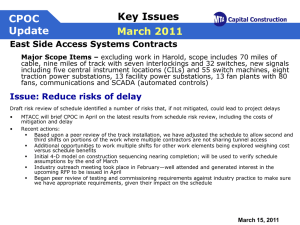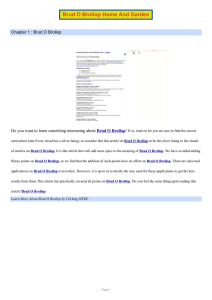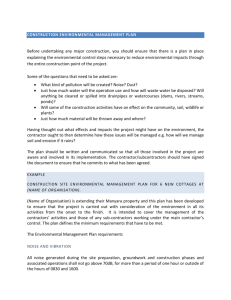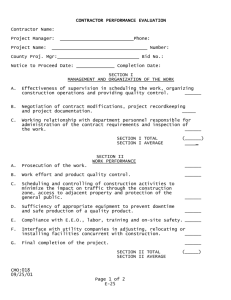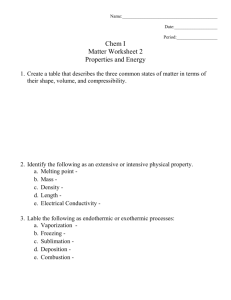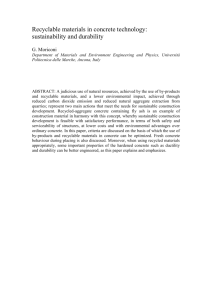S126 Minimum Specification for Geomembrane
advertisement
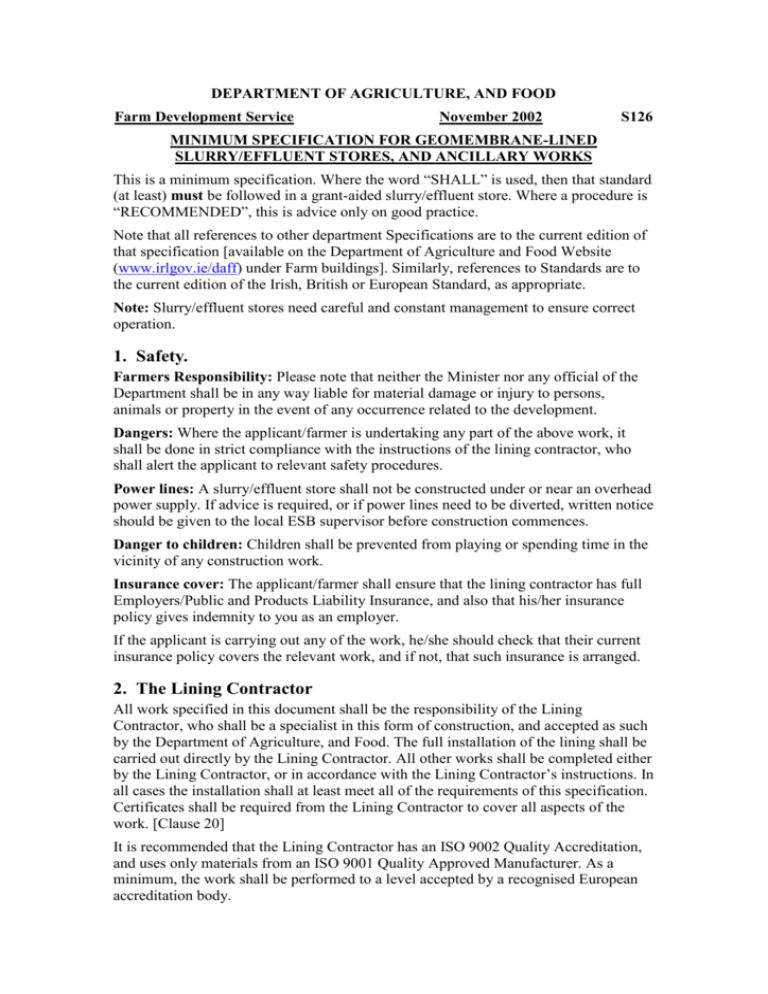
DEPARTMENT OF AGRICULTURE, AND FOOD Farm Development Service November 2002 S126 MINIMUM SPECIFICATION FOR GEOMEMBRANE-LINED SLURRY/EFFLUENT STORES, AND ANCILLARY WORKS This is a minimum specification. Where the word “SHALL” is used, then that standard (at least) must be followed in a grant-aided slurry/effluent store. Where a procedure is “RECOMMENDED”, this is advice only on good practice. Note that all references to other department Specifications are to the current edition of that specification [available on the Department of Agriculture and Food Website (www.irlgov.ie/daff) under Farm buildings]. Similarly, references to Standards are to the current edition of the Irish, British or European Standard, as appropriate. Note: Slurry/effluent stores need careful and constant management to ensure correct operation. 1. Safety. Farmers Responsibility: Please note that neither the Minister nor any official of the Department shall be in any way liable for material damage or injury to persons, animals or property in the event of any occurrence related to the development. Dangers: Where the applicant/farmer is undertaking any part of the above work, it shall be done in strict compliance with the instructions of the lining contractor, who shall alert the applicant to relevant safety procedures. Power lines: A slurry/effluent store shall not be constructed under or near an overhead power supply. If advice is required, or if power lines need to be diverted, written notice should be given to the local ESB supervisor before construction commences. Danger to children: Children shall be prevented from playing or spending time in the vicinity of any construction work. Insurance cover: The applicant/farmer shall ensure that the lining contractor has full Employers/Public and Products Liability Insurance, and also that his/her insurance policy gives indemnity to you as an employer. If the applicant is carrying out any of the work, he/she should check that their current insurance policy covers the relevant work, and if not, that such insurance is arranged. 2. The Lining Contractor All work specified in this document shall be the responsibility of the Lining Contractor, who shall be a specialist in this form of construction, and accepted as such by the Department of Agriculture, and Food. The full installation of the lining shall be carried out directly by the Lining Contractor. All other works shall be completed either by the Lining Contractor, or in accordance with the Lining Contractor’s instructions. In all cases the installation shall at least meet all of the requirements of this specification. Certificates shall be required from the Lining Contractor to cover all aspects of the work. [Clause 20] It is recommended that the Lining Contractor has an ISO 9002 Quality Accreditation, and uses only materials from an ISO 9001 Quality Approved Manufacturer. As a minimum, the work shall be performed to a level accepted by a recognised European accreditation body. 3. Planning Permission In every case planning permission shall be obtained for this type of slurry/effluent store. It shall be clearly stated in the application for permission to the Local Authority, that the proposed structure is to be a geomembrane-lined store. 4. Storage Capacity The storage capacity of the slurry/effluent store shall comply with the conditions attached to the granting of Planning Permission by the Local Authority. Where such conditions have not been imposed, the capacity shall be in accordance with the current requirements of the Department of Agriculture and Food, and the Department of Environment and Local Government. In calculating the capacity of the slurry/effluent store, the maximum top level of the effluent shall be taken at 300mm below the lowest slurry channel invert. 5. Location The location of any lined slurry/effluent store shall be in compliance with all requirements of planning permission and other statutory regulations. Additionally the location should be at a suitable remove from busy work areas, or from circulation areas in the farmyard, or from trees. No part of the structure shall be directly under any power line, and the fence line must not run under any nearby trees [Clauses 1 and 18]. Site investigations shall take place to determine ground water level, bedrock depth and subsoil type. Trial pits need only to be sunk to one metre below the expected lowest level of the store. A storage facility shall be located not less than 50m from any waterbody in the case of new farmyards, and not less than 10m in the case of extensions/modifications to an existing facility. The minimum distance between a storage facility and a public or domestic water supply source, either surface or ground, shall be 60m. In vulnerable situations this distance should be increased up to 300m. 6. Ground Conditions The proposed site shall be free of bedrock [clause 11]. The water table at its estimated highest point, or at its cut-off point where ground water table drainage is to be provided, shall be at or below the leak detection layer [clause 10]. 7. Construction On all sites, the topsoil within the slurry/effluent store perimeter and for a minimum distance of 1.5m outside it shall be removed. The banks of the store shall be not less than 600mm high above ground level and be well-compacted. The banks may be constructed of suitable excavated material as assessed by the lining contractor. 8. Bank Stability The banks shall be excavated to a slope, which will maintain stability in the prevailing ground conditions and with regard to the soil type. The slope angle shall normally be 45o, but in certain soils the angle may be steeper. In no circumstance shall the bank slope be steeper than 55o. The banks shall be wide enough to allow permanent stability of the bank and for safe access to the chosen agitation point(s). 2 9. Air and Gas Escape Suitable provision shall be made to ensure the escape of any trapped gas or air from beneath the liner, particularly during construction. 10. Leak detection system. A leak detection system shall be installed underneath the geomembrane-lining. This shall consist of one of the following: 1) 50mm land drainage pipes, spaced at 2.5m intervals under the layer of pea gravel [clause 11]. 2) Flat geocomposite drainage tubing (for example Colbondrain) laid in a fan-like fashion and brought to one 160 mm diameter pipe that exits the lagoon sidewall. These drainage pipes may be laid over or under the pea gravel. The pipes, in both cases, shall be brought to a 1000 litre inspection chamber so that monitoring of the discharge can be undertaken. 11. Surface Preparation The excavated and/or made-up ground must be finished uniform and smooth and free of any sharp protuberances. In particular, the surfaces to be lined must be free of water, jagged rock, debris, roots or any matter that could damage the lining material. A minimum 75mm layer of pea gravel (10mm max particle size) shall be used on all slurry/effluent store floors. In stony ground a quarry dust layer (5mm to fines), 50mm thick, shall be applied on all side slopes. Before lining commences the formation shall be examined by the Lining Contractor to ensure suitability. An acceptance certificate will then be issued to record that the ground preparation has been carried out in full accordance with the Contractor’s recommendations [Clause 20]. The first portion of the contractors certificate shall be completed at this stage. 12. Anchoring Trench The anchor trench shall be carefully formed and compacted, and any undisturbed top soi1 beneath it shall be removed. The anchoring trench shall be at least 500mm back from the slurry/effluent store edge and it shall be excavated at least 300mm wide and 500mm deep. When the liner has been installed in the prepared store, at least 500mm of liner all round should be available for burial in the anchor trench, which shall then be backfilled and compacted. 13. Liner The Material Specification of the proprietary geomembrane-Lining Material shall be provided to the Department and the material recorded as accepted by them before the Lining Contractor is approved. The Lining Contractor shall also forward details of their Quality Control System and their acceptance as a Quality Approved Company by an independent Quality Regulatory Body. Any change to the specification of that material shall also require approval by the Department. The liner shall be laid and jointed by the Lining Contractor strictly in accordance with the manufacturer’s instructions. When laid, the liner shall be free of creasing, and bulges shall not exceed 150mm height. Liner installation shall not take place in temperatures below 5°C or above 30°C. 3 The lining contractor certificate shall state that the material used is of the same standard as that which has been previously accepted, and that all the welds have been examined and have passed all relevant tests. The Certificate shall also incorporate a guarantee that the Lining shall remain watertight for a minimum of 30 years. 14. Agitation and Emptying Points The proposed method of agitation should be carefully selected prior to construction, and the number of agitation points shall be agreed between the Lining Contractor, the applicant and his Planner before any excavation works proceeds. The number of agitation points required will vary depending on the depth, size and shape of the slurry/effluent store in question. The number of chosen points should be kept to the minimum necessary for complete agitation. During construction, all requirements of the selected system shall be incorporated in the structure. Agitation point(s) shall consist of a) a tractor access point; b) a concrete footing (reinforced with steel reinforcing mesh, minimum A142) of sufficient size so that at its edges, turbulence will be dissipated to a level which will not endanger the liner, but in all cases at least 2 metres square; and c) a concrete apron at least 1m wide and 100mm thick, steel mesh reinforced (min A142), extending from the tractor stand, down the slope to the near edge of the agitator footing. Alternatively, the Agitation point(s) shall consist of a tractor access point; a 10mm HDPE Plate footing (welded to the store liner) of sufficient size so that at its edges, turbulence will be dissipated to a level which will not endanger the liner, but in all cases at least 2 metres square; and a 10mm HDPE Plate apron at least 1m wide (welded to the side slope liner), extending from the tractor stand, down the slope to the near edge of the agitation footing. Suitable arrangements may be provided by way of sump(s) so that the total contents can be more easily removed. Any sump shall be constructed in concrete, or alternatively constructed with a 10mm thick stock sheet of approved leak-proof material. Any joints between the sump and the liner shall be tested and be guaranteed as leak-proof by the Contractor. Note: All agitation equipment shall be provided with protective steel grills so as to prevent contact between the rotor and the liner. 15. Pipe Connections/Concrete Inlet Channels Any pipe connections to the facility must be carried out by trained staff and all joints must be totally leak proof. Pipes shall be installed so that no weight is transferred to the liner. Where concrete inlet channels are being used and where such channels are below the anticipated top water level within the tank, an impervious anchor profile or collar of approved design will be cast into the concrete at the interface of the concrete channel/liner. The liner shall then be welded directly to the anchor profile to achieve a guaranteed watertight seal between the liner and the concrete inlet channel. 16. Tractor Access Tractor access for agitating shall be through a gated opening in the surrounding fence, at least 1.8m high and normally 3.6m wide. The access route shall be concreted from the fence line to store edge. The access point and tractor stand shall either be level or shall slope moderately away from the pit edge. Close to the pit edge there shall be a 4 raised kerb (wheel stop), at least 300mm high and 600mm wide, across the whole access point [A gap, maximum 1m wide, may be positioned in the centre of the wheel stop to facilitate the use of agitation equipment.]. The wheel stop shall also be cast into the excavated anchor trench, at least 500mm deep. A tubular steel safety barrier, at least 1.2m high, shall be provided around the access point. 17. Emergency Ramps/Ladders At each corner of the slurry/effluent store there shall be a facility provided which will permit emergency access or escape. This shall consist of a tyre ladder, suitably constructed and anchored, or any other suitable means. Further such facilities shall be provided at intervals not exceeding 8m around the perimeter of the slurry/effluent store. 18. Protective Fencing A stock proof and childproof fence, 1.8m high, shall be provided around all slurry/effluent stores. Posts shall be a minimum 2.3m long of either:a) Reinforced concrete 125mm x 125mm at butt end (to IS 177: 1980) b) Galvanised angle iron 60mm x 60mm x 6mm thick c) Galvanised tubular steel, 75mm outside diameter, and 3.2mm thick Uprights and strainers shall be embedded at least 400mm into 0.5m square concrete bases, not more than 3.0m apart. Four strands of 3.2 mm plain wire shall be strained, and stapled or tied to the uprights with tying wire. Chain link fencing, 2.5mm, (to IS 130:180), 1.8m high, shall be secured to the outside of the line wires over entire fence. One strand of 2.5mm barbed wire shall be placed along the top of the fence. The entrance gate shall be of tubular steel construction and be galvanised. The only horizontal bars shall be at the top and bottom of the gate. The gate shall be covered with chain link fencing to the outside so as to prevent climbing of gate. The gate shall be designed such that it can be closed securely, and that either people or stock cannot get through or under when closed. The top of the gate shall be a minimum of 1.8m off the ground. Other proprietary fence systems will be acceptable if the above criteria are met. 19. Warning Signs Warning signs shall be erected at the entrance to the store, stating “SLURRY STORE: DANGER OF DROWNING”. 20. Certification The following Certificates shall be provided to the applicant for submission to the Department before grant-aid can be certified for payment. 1. ‘Concrete’ Certificate [clause 21] 2. Contractors Certificate of Ground Preparation and Leak Tightness for Geomembrane-lined Slurry/Effluent Stores [Appendix A]. 5 21. CONCRETE 21.1 Concrete for all works shall be purchased on the basis of a characteristic 28 day crushing strength of 40N/ mm2 [EN206 Class C32/40]. Minimum cement content shall be 350kg/m3. The slump of unplasticised concrete shall not exceed 75mm [EN206 Class S2]. Maximum aggregate size shall be 20mm. 21.2 Cement used in concrete and concrete products shall be certified to I.S.I. 1991, or shall be certified by N.S.A.I. to be equivalent to I.S.I. 1991. All aggregate shall be I.S. 5, 1990. Plasticisers and other admixtures shall be used in strict accordance with manufacturer's instructions, and shall be added only by the concrete-mix manufacturer. 21.3 A numbered certificate, signed and stamped, shall be required for all concrete delivered to site or for concrete made on site by contractors. This certificate, the 'Concrete Manufacturers Specification Certificate', is produced in triplicate. The top certificate printed on light blue paper shall be retained by applicant and given to the Department for inspection upon completion of works. 21.4 Polypropylene fibres can be incorporated into the concrete mix to improve the properties of fresh concrete. The use of fibres helps in the reduction of plastic cracking and crazing, and may also improve surface durability. However, they are not a substitute for structural reinforcement. Where fibres are used in concrete they shall be used in strict compliance with manufacturers’ instructions and shall only be added at the Concrete Manufacturers Mixing Plant. The concrete Certificate (see 3 above) shall clearly show the amount and type of fibre added. 21.5 It is recommended that concrete samples be taken and tested in accordance with B.S. 1881. 6 Appendix A. – Contractors Certificate of Ground Preparation and Leak Tightness for Geomembranelined Slurry/Effluent Stores. To be reproduced on contractors headed paper as per sample given overleaf. 7 [Certificate to be typed on Lining Contractors Headed Paper] Contractors Certificate of Ground Preparation and Leak Tightness for Geomembrane-lined Slurry/Effluent Stores (To be completed by lining contractor) Name of Client: ______________________________________________ Address of client: ______________________________________________ ______________________________________________ ______________________________________________ ______________________________________________ I hereby certify that the excavation and preparation work performed is of the required standard to at least meet the requirements of the Department of Agriculture and Food specification S126, ‘Minimum Specification For Geomembrane-Lined Slurry/Effluent Stores, and Ancillary Works’. Name of contractor preparing site: __________________________________ Address of contractor preparing site: __________________________________ __________________________________ __________________________________ __________________________________ Date site certified ready for lining: __________________________________ Name and position of person certifying preparation work: ________________ __________________________________ Signature of person certifying preparation work: ______________________ It is further certified that the geomembrane-lining has been installed to, at least, the standard of specification S126, and is hereby certified as leak tight. It is also certified that all safety features have been installed. Date of certification: __________________________________ Name and position of person certifying lining: ____________________________ ______________________ Signature of person certifying lining: __________________________________ Company Stamp of Lining contractor: 8


